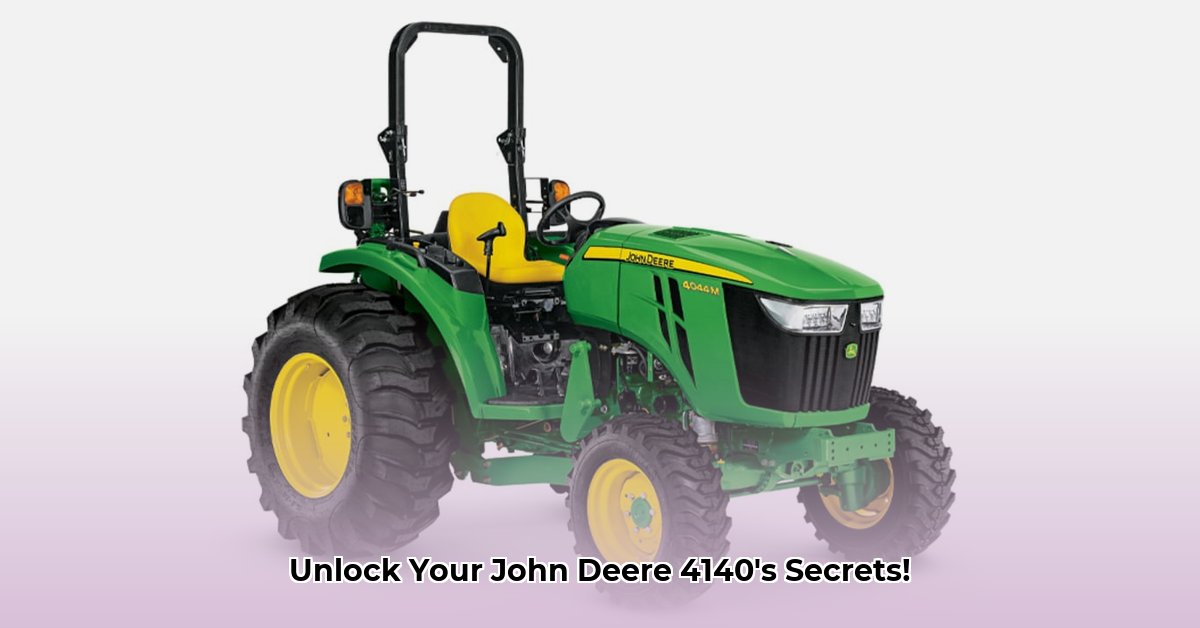
So, you've encountered the enigmatic "John Deere 4140" tractor. Many have, but it's time to clear up a long-standing industry myth: a true John Deere 4140 model doesn't exist. What's commonly referred to as a 4140 is almost invariably a John Deere 4000SU. This definitive guide unravels the mystery, providing the knowledge you need to identify, maintain, and appreciate your machine, regardless of its colloquial name. Whether you're a seasoned mechanic or a curious owner, this guide will equip you with the information you need. Let's get started!
Understanding the John Deere 4000 Series: A Complex Family
The John Deere 4000 series, produced between 1969 and 1972, comprises a range of tractors with subtle yet significant variations. Understanding these differences is crucial for accurate identification and parts sourcing. These weren't just minor cosmetic changes; these tractors varied considerably in engine options, transmission types, and even chassis designs. This inherent variety is the root of the ongoing confusion surrounding the "4140" designation.
The 4000SU: Unveiling the "4140"
The "4140" you've heard about? It's almost always a 4000SU. This model, often described as a workhorse, offered a blend of power and efficiency. It typically featured a robust three-cylinder engine, known for its reliability and simplicity. Common characteristics included a three-point hitch system (for attaching implements) and a power take-off (PTO) shaft for operating auxiliary machinery. Even within the 4000SU lineup, minor variations exist, dependent on manufacturing year and optional factory-installed equipment.
Comparing the 4000SU to its Siblings: 3910 and 4110
The 4000SU frequently gets confused with similar models, such as the 3910 and 4110. While visually similar, critical distinctions exist that impact both performance and parts compatibility. Understanding these differences is essential for both correct identification and effective maintenance.
| Feature | 3910 | 4000SU ("4140") | 4110 |
|---|---|---|---|
| Engine Cylinders | Typically 4 | Typically 3 | Typically 4 |
| Horsepower | Generally Higher | Generally Lower | Generally Higher |
| Chassis | Standard/LCG | Standard | Standard/LCG |
| Oil Cooler | Often Present | Often Absent | Often Present |
(LCG denotes Low Center of Gravity chassis, offering enhanced stability on slopes.)
Note the significant differences in engine cylinders and horsepower, directly influencing the tractor's capabilities and energy requirements. The presence of an oil cooler is another critical visual differentiator.
Identifying Your Tractor: A Step-by-Step Guide
To ensure correct part acquisition and maintenance, precise identification is paramount. Follow these steps to definitively identify your 4000SU ("4140"):
Locate the Serial Number: This unique identifier, typically found on a metal plate attached to the tractor's frame or engine, is your starting point.
Online Resources: Utilize online databases (such as TractorData.com) to input the serial number. These databases often contain comprehensive specifications for various John Deere models. Isn't it fascinating how technology helps us trace the history of these powerful machines?
Engine Inspection: Examine the engine block for additional identification numbers. These numbers serve as an independent verification of the tractor's model.
Visual Comparison: Compare your tractor’s physical characteristics with online images and documentation. Pay close attention to nuanced features like the engine type, chassis design, and the presence or absence of specific components, such as an oil cooler. This visual verification step significantly improves the accuracy of your identification.
Addressing Common Issues and Maintenance
Regular maintenance is vital for prolonging the life of your 4000SU. Common problems include hydraulic leaks (requiring prompt attention), electrical system malfunctions (often stemming from corrosion), and typical engine wear associated with older equipment. A service manual specific to the 4000SU model is your most valuable resource.
Sourcing Parts: Avoiding the "4140" Pitfall
When ordering parts, avoid using the ambiguous "4140" to reference your tractor. Always use the correct model designation (4000SU) and serial number. This ensures accurate part procurement, preventing costly errors and delays. Online retailers specializing in vintage agricultural equipment or contacting John Deere dealers directly are the most effective strategies.
Conclusion: Solving the Mystery
While the term "4140" persists, accurately identifying your tractor as a 4000SU is crucial for maintenance and parts sourcing. By employing the steps outlined in this guide, you can confidently maintain and appreciate this classic workhorse, ensuring its continued service on your farm or property. Remember, precise identification is the key to its longevity and effectiveness.